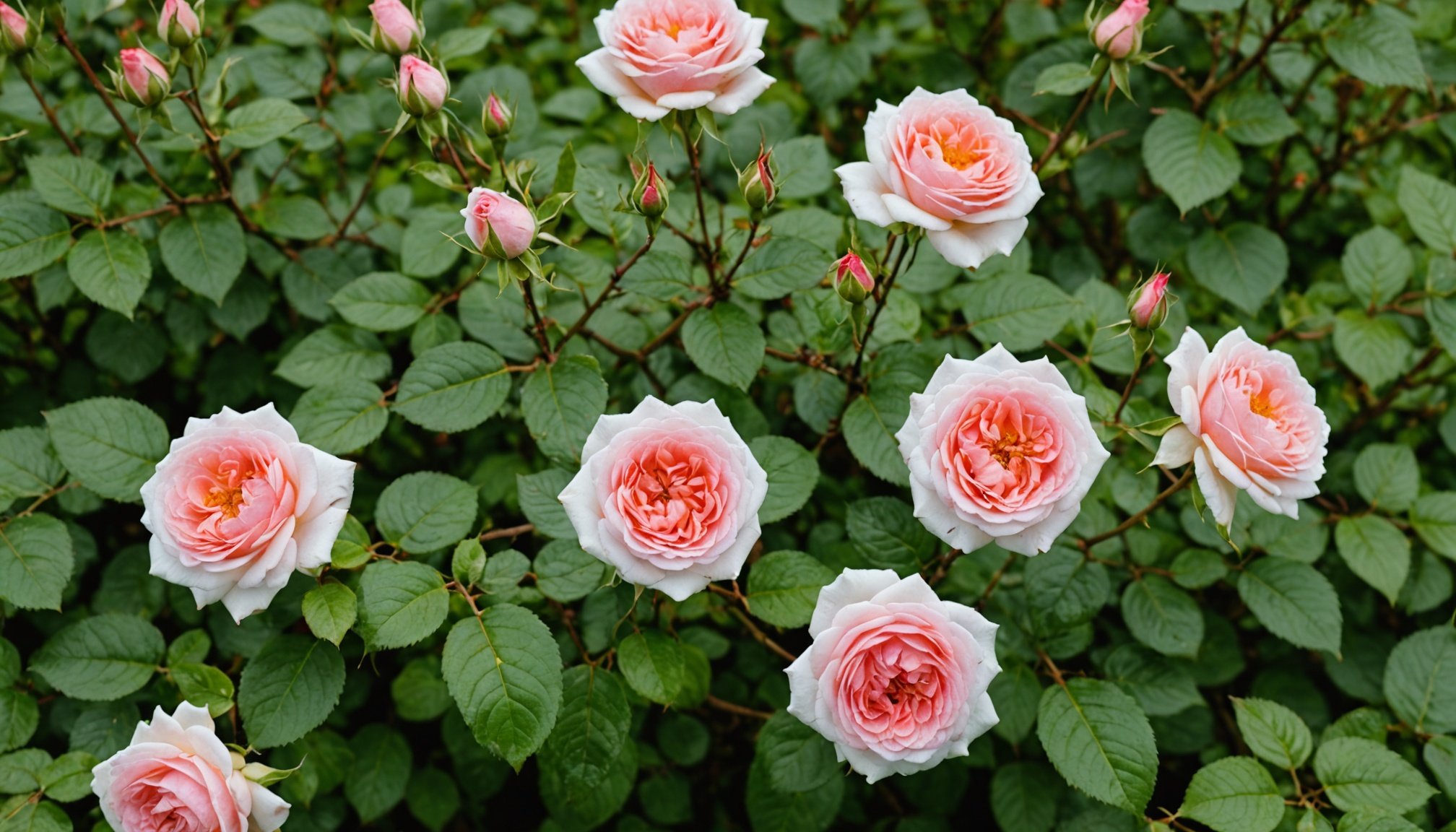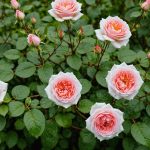Top Natural Solutions to Combat Rose Black Spot in Humid UK Climates
Understanding Rose Black Spot: The Fungal Menace
Rose black spot, caused by the fungus Diplocarpon rosae, is a common and serious disease that can wreak havoc on your rose garden, especially in the humid climates of the UK. This fungal disease manifests as round black spots with fringed edges on the leaves of your rose plants, often leading to defoliation and weakened plant health.
To effectively combat this disease, it’s crucial to understand its lifecycle and how it spreads. Fungal spores are typically dispersed by water, whether it’s rain or irrigation, and they thrive in moist environments. Here are some key points to consider:
Also read : Top Indoor Seed Starting Methods for UK Gardeners: Unlock Your Green Thumb
- Moisture: High humidity and frequent watering create an ideal environment for fungal spores to germinate and infect your plants.
- Infected Leaves: Infected leaves can fall to the ground, where the fungus can overwinter and reinfect the plant the following growing season.
- Air Circulation: Poor air circulation around your rose plants can exacerbate the problem by trapping moisture and preventing the leaves from drying out.
Natural Fungicides: Effective Alternatives to Chemicals
When it comes to controlling rose black spot, many gardeners are turning to natural fungicides as a safer and more sustainable alternative to chemical treatments. Here are some of the top natural solutions you can use:
Neem Oil
Neem oil is derived from the seeds of the neem tree and is known for its broad-spectrum fungicidal properties. It works by inhibiting the growth of fungal spores and can be used as a preventative measure as well as a treatment.
Also to see : Top Plant Selections for Creating an Enchanting Victorian Garden in Central London
- Mix 2-4 teaspoons of neem oil with 1 quart of water.
- Add a small amount of mild dish soap to help the oil emulsify.
- Spray the solution on the leaves and stems of your rose plants, ensuring thorough coverage.
Baking Soda
Baking soda is another effective natural fungicide that can help control rose black spot. Here’s how you can use it:
- Mix 1 tablespoon of baking soda with 1 gallon of water.
- Add a small amount of mild dish soap to help the solution stick to the leaves.
- Spray the solution on the infected areas, making sure to cover both the upper and lower surfaces of the leaves.
Copper-Based Solutions
Copper has natural antifungal properties and can be used in the form of copper-based sprays. These solutions are particularly effective against a range of fungal diseases, including black spot.
- Use a commercial copper-based fungicide according to the manufacturer’s instructions.
- Ensure thorough coverage of all plant parts to prevent the spread of the disease.
Additional Strategies for Disease Control
While natural fungicides are a crucial part of your arsenal against rose black spot, they should be used in conjunction with other strategies to ensure comprehensive disease control.
Improve Air Circulation
Good air circulation is essential for preventing the spread of fungal diseases. Here are some tips to improve air circulation in your garden:
- Prune Plants: Prune your rose plants to allow more air to circulate around them.
- Space Plants: Ensure that your rose plants are spaced adequately to prevent overcrowding.
- Remove Weeds: Keep the area around your rose plants weed-free to reduce moisture retention.
Water Wisely
How you water your plants can significantly impact the spread of rose black spot. Here are some water management tips:
- Avoid Overwatering: Avoid watering your plants in the late afternoon or evening, as this can encourage moisture to remain on the leaves overnight.
- Use Drip Irrigation: Use drip irrigation or soaker hoses to deliver water directly to the soil, reducing the amount of moisture on the leaves.
Remove Infected Leaves
Removing infected leaves is a critical step in controlling the spread of rose black spot. Here’s how you can do it effectively:
- Dispose of Infected Leaves: Remove and dispose of any infected leaves to prevent the fungus from spreading.
- Clean Tools: Clean your pruning tools with a mixture of 1 part bleach to 10 parts water to prevent the spread of the fungus.
Soil Health and Disease Resistant Varieties
Maintaining healthy soil and choosing disease-resistant rose varieties can also play a significant role in combating rose black spot.
Soil Health
Healthy soil with good drainage and a balanced pH can help your rose plants resist fungal diseases. Here are some tips to improve your soil health:
- Add Organic Matter: Add compost or well-rotted manure to your soil to improve its structure and fertility.
- Check pH Levels: Ensure your soil pH is within the optimal range for rose plants (around 6.0-6.5).
Disease-Resistant Varieties
Choosing rose varieties that are naturally resistant to black spot can reduce the need for frequent fungicide applications. Here are a few examples of disease-resistant rose varieties:
| Rose Variety | Disease Resistance |
|---|---|
| ‘Knock Out’ Roses | High |
| ‘Drift’ Roses | High |
| ‘English Rose’ Series | Moderate |
Practical Insights and Actionable Advice
Here are some practical insights and actionable advice to help you effectively combat rose black spot in your garden:
Monitor Your Plants Regularly
Regular monitoring is key to catching the disease early. Check your plants frequently for signs of black spots, especially during the growing season.
Use a Combination of Methods
Using a combination of natural fungicides, improving air circulation, and practicing good water management can provide comprehensive protection against rose black spot.
Keep Your Garden Clean
Keep your garden clean by removing fallen leaves and debris, which can harbor fungal spores and reinfect your plants.
Real-Life Examples and Anecdotes
Many gardeners have successfully combated rose black spot using natural methods. Here’s an example:
“I used to struggle with black spot on my rose plants every year, but after switching to neem oil and improving air circulation around my plants, I’ve seen a significant reduction in the disease. Now, my roses are healthier and more vibrant than ever!” – Sarah, a UK gardener.
Combating rose black spot in humid UK climates requires a multi-faceted approach that includes natural fungicides, improved air circulation, wise water management, and maintaining healthy soil. By understanding the disease and using a combination of these strategies, you can keep your rose plants healthy and thriving.
Here is a detailed bullet point list summarizing the key points:
- Natural Fungicides:
- Neem oil
- Baking soda
- Copper-based solutions
- Improve Air Circulation:
- Prune plants
- Space plants adequately
- Remove weeds
- Water Wisely:
- Avoid overwatering
- Use drip irrigation or soaker hoses
- Remove Infected Leaves:
- Dispose of infected leaves
- Clean tools with bleach solution
- Soil Health:
- Add organic matter
- Check and maintain optimal pH levels
- Disease-Resistant Varieties:
- Choose varieties like ‘Knock Out’ or ‘Drift’ roses
- Monitor Your Plants Regularly:
- Check for signs of black spots frequently
- Keep Your Garden Clean:
- Remove fallen leaves and debris
By following these tips and using natural solutions, you can enjoy a beautiful and healthy rose garden even in the humid UK climate.
User Experiences and Testimonials
When exploring various natural remedies, insight from real users can be invaluable. Many individuals share their experiences on online forums, illustrating the effectiveness of different approaches. Whether it’s herbal solutions or lifestyle changes, real-world results speak volumes, helping others navigate their wellness journeys.
Compilation of User Experiences
A common theme in user testimonials is the discovery of what works best for individual needs, as personal conditions can vary widely. For instance, some users have noticed significant improvements using holistic techniques like aromatherapy, while others find dietary adjustments more beneficial. It’s informative to compare these shared stories, as they highlight diverse paths to enhanced wellbeing.
Community Advice
The community-driven aspect of wellness forums also offers additional support. Engaging with user testimonials often leads to community advice on selecting remedies or combining techniques for optimal outcomes. Furthermore, these platforms frequently suggest additional resources like reputable books or online courses to deepen users’ understanding. This wealth of information illustrates the importance of collective wisdom and shared experiences in the quest for effective natural remedies.
By tapping into this community knowledge and advice, individuals can make informed decisions, tailoring their approaches to health based on what has been proven effective for others facing similar challenges.
Additional Resources and Visual Aids
In navigating the complexities of rose care, guides and infographics prove invaluable. These resources translate intricate concepts into digestible formats. Let’s delve deeper into these supportive materials.
Infographics on Disease Management
Infographics offer a visually appealing way to grasp preventive measures and treatments for common rose diseases. They simplify complicated information by breaking it down into key components, making it easier to retain. Furthermore, how-to guides can be valuable in creating natural remedies, aiding in developing a sustainable approach to disease management. Incorporating visual aids in understanding such concepts allows even novice gardeners to achieve successful outcomes.
Links to Expert Opinions
Connecting with seasoned experts can inspire confidence in rose care practices. Expert blogs and articles shed light on diverse approaches to nurturing roses, presenting varied methodologies and insights. Recommendations for books on organic gardening serve as guided pathways for those eager to expand their knowledge. Additionally, access to forums and online communities offers ongoing support, encouraging engagement and the sharing of personal experiences. This collaborative environment nurtures learning and growth within the gardening community.











